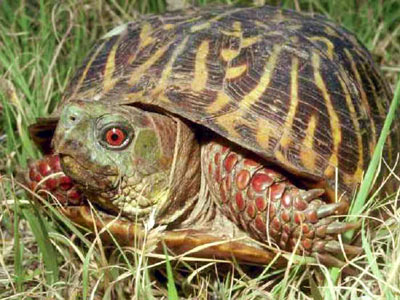Amphibians and reptiles may occupy similar habitats and can be found in most habitat types. Some species use different habitats at different times of the year. Some turtles, for example, spend most of their time in the water, but must move to land to lay eggs.
Many salamanders inhabit upland habitats for most of the year, but require temporary or permanent wetlands or aquatic sites to breed and lay eggs. Additionally, many herpetofauna species become less active during periods of extreme cold or heat, and at such times they seek out protected sites.

Colorado Parks and Wildlife
Depending on the species and location, amphibians may need sites for burrowing in moist soil or wet areas to keep their skin moist (Marks 2006). Near wetlands and riparian areas, amphibians use a variety of upland microhabitats, including leaf litter, woody material, small mammal burrows, and boulders and cracks in rocks. Reptiles require sites that contain shelters from the heat and basking areas in the sun. Microhabitats used during times of extreme cold or heat include rock piles or outcroppings, animal burrows, woody material, and brush piles. Many snakes and lizards would also find these suitable areas for nesting.
A description of adaptations of amphibians and reptiles for living in desert environments is found in Van Devender (2000). These adaptations include the ability to excavate deep burrows where the animal may stay for substantial periods of time (e.g., Couch’s spadefoot [Scaphiopus couchi], northern casque-headed frog [Pternohyla fodiens]). These species are aided in digging with spades on their hind feet. Further, the casque-headed frog sheds outer layers of skin while in its burrow to form a cellophane-like “cocoon” that prevents water loss. Reptiles such as the chuckwalla (Sauromalus obesus) and Gila monster (Heloderma suspectum) store water in the fatty tissues of their tails. Adaptations also exist for living in loose, windblown sand. For example, the fringe-toed lizard (Uma spp.) gains traction while running across dunes with the fringe-like scales on the elongated toes of its back feet.
Amphibians and reptiles are both important members of aquatic and terrestrial ecosystems. Both groups serve as both predators and prey, and species that inhabit both ecosystems serve to transfer energy between the two systems. A discussion of the roles that snakes play as ectothermic predators can be found in Nowak et al. (2008). One of the authors’conclusions was that the potential for the viperids (true vipers and pit vipers) to regulate prey populations would be greatest when prey populations are low.

Colorado Parks and Wildlife
Amphibians are viewed as indicators of wetland ecosystem health. They are sensitive to a variety of threats and, thus, can serve as early indicators of ecosystem change when monitored over long time scales. Changes in amphibian populations can often be linked to one of the following causes, all of which suggest a decrease in overall ecosystem health: pollution, introduced species, drought, habitat destruction, disease, and ultraviolet radiation. Amphibian populations may exhibit measurable changes in site occupancy, distribution, abundance, species richness, and increases in both disease occurrence and malformations. These changes have cascading effects on other aspects of the ecosystem, such as predator, prey, and competitor populations, energy flow, and nutrient cycling (Stebbins and Cohen 1995).
Activity and behaviour of both amphibians and reptiles are affected by local weather conditions during the year. For example, lower rainfall and higher temperatures can significantly affect microhabitat in an area, and reduce the likelihood of observing amphibians, and to a lesser extent reptiles, for some period of time. This may result in lower recorded population levels during subsequent seasons and years. Similarly, daily activity of reptiles may be affected by rain and/or cold weather. These effects of local weather conditions can hamper short-term studies of herpetofauna, especially in the dry Southwest (Johnson and Lowe 1979, Lowe and Holm 1991). Effects of drought on herpetofauna are discussed further in the following section, under “Drought.”
Part of a series of articles titled Reptiles and Amphibians of the American Southwest.
Last updated: July 1, 2015
